The Secret Life of Second Hand Clothes
Episode #32
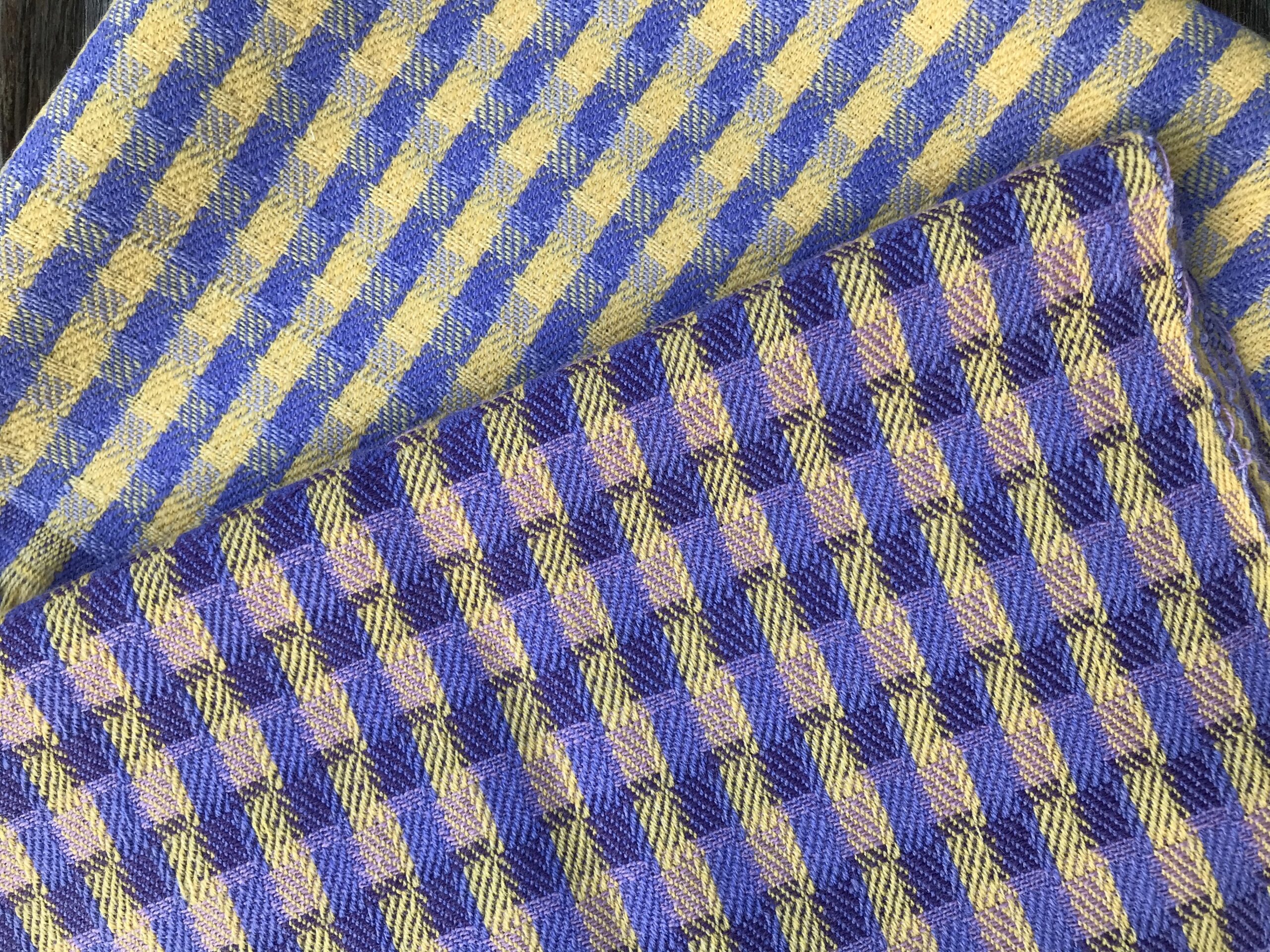
This episode of Haptic and Hue is about the past, the present, and what could be the future of second-hand clothes and textile recycling. Once we lived in an age when yarns and fabrics were hard-won and precious. Today we live in an era of textile excess where cloth production uses far too much of the world’s precious resources for clothes that we wear a few times and then throw away. But it doesn’t have to be like this. Come on a journey with Haptic and Hue to discover the secrets of second-hand clothes and find out what the future might look like.
The people you hear in this episode are:
Rebecca Devaney of Textile Tours of Paris – who also gives expert online embroidery classes. You can find her website at https://www.textiletoursofparis.com/. She is on Instagram at https://www.instagram.com/textile_tours_of_paris/
Kirk Bradley works for the Trading Arm of the Salvation Army. https://www.satcol.org/They have an excellent video about the new Fibresort machine which you can see here: https://www.satcol.org/satcol-tv
Harriet Adjabeng can be found on Instagram as https://www.instagram.com/akuvi.adjabs/ Harriet works as the Sustainable Fashion Lead for Ghana’s Youth Environmental Movement (GYEM), a youth-led advocacy group mobilizing young people to address environmental challenges in Ghana. It runs a great campaign on the fashion waste coming into the country. You can find out more here.
John and Linda Parkinson can be found at https://www.iinouiio.com/ or on Instgram https://www.instagram.com/iinouiiorecycledtextiles/ You can find the video of their first shoddy run on Vimeo at https://vimeo.com/736486368
You can follow Haptic and Hue on Instagram @hapticandhue on Facebook or Linked In under the Haptic and Hue name.
There are lots of excellent videos on the problems of recycling and dumping second-hand clothes. Here’s one about the Atacama Desert https://www.youtube.com/watch?v=uyHgY2O__fY
And here’s one on the problems of the second hand clothes market in Ghana https://www.youtube.com/watch?v=MHnDqelUh-4
Books I have enjoyed and found useful follow: where there are links you can find them in the UK and US Haptic & Hue Bookshops. Buying them here gives Haptic & Hue a small commission at no extra cost to you.
Lisa Woollett: A History of What We Have Thrown Away. UK Bookshop
Andrew Brooks: Clothing Poverty – the Hidden World of Fast Fashion and Second Hand Clothes. UK Bookshop US Bookshop
Maxine Bédat: Unravelled – The Life and Death of a Garment. US Bookshop UK Bookshop

Rebecca Devaney
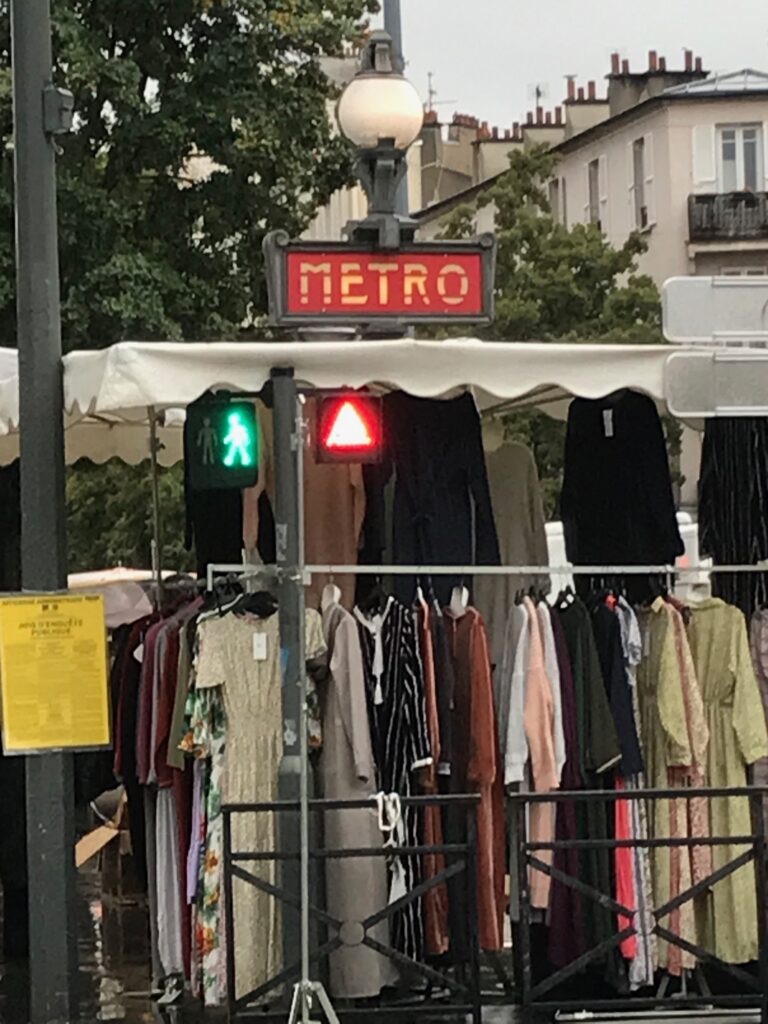
On the way to the Flea Market, Paris
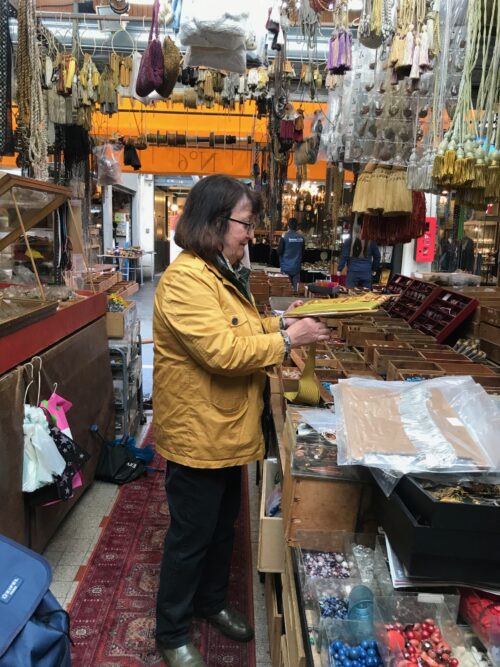
Lili of Lili and Daniel
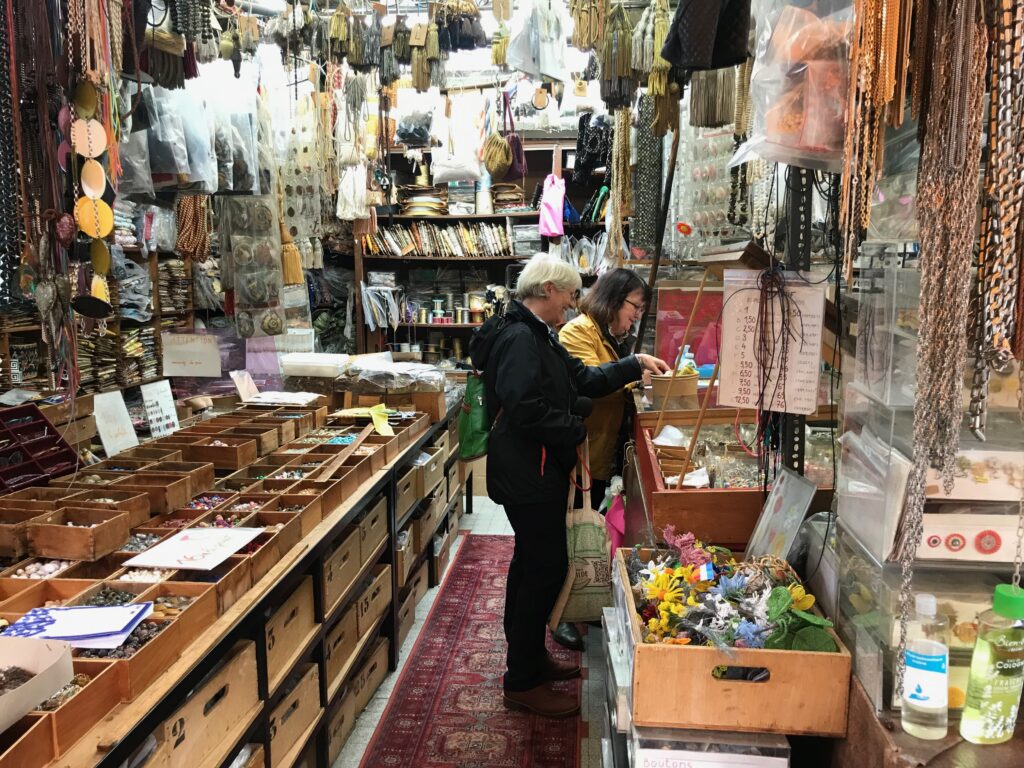
Flea Market Glories
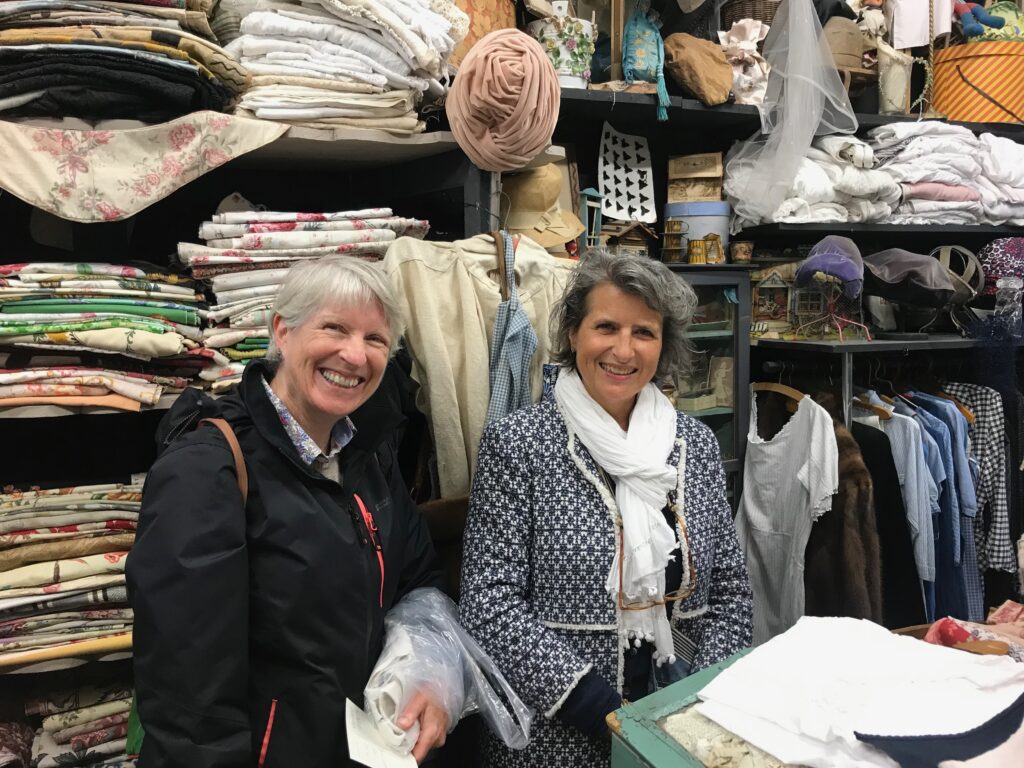
Jo with Laure
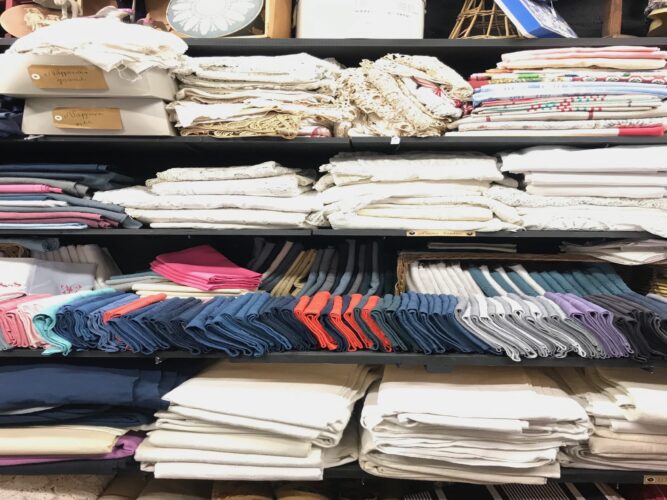
100 year old linens and workclothes

Kirk Bradley – of the Salvation Army’s Trading Arm
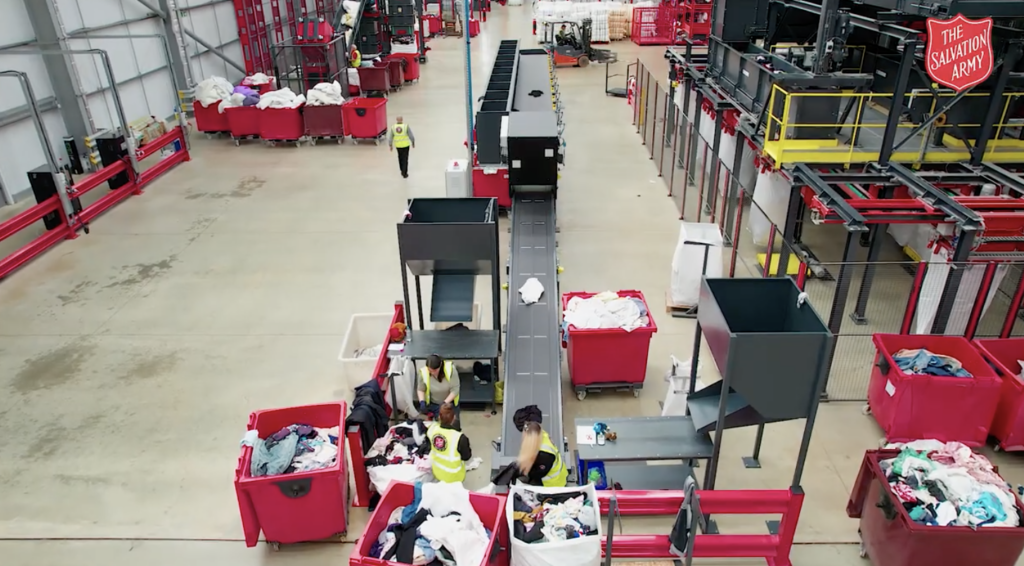
The New Fibresort Machine
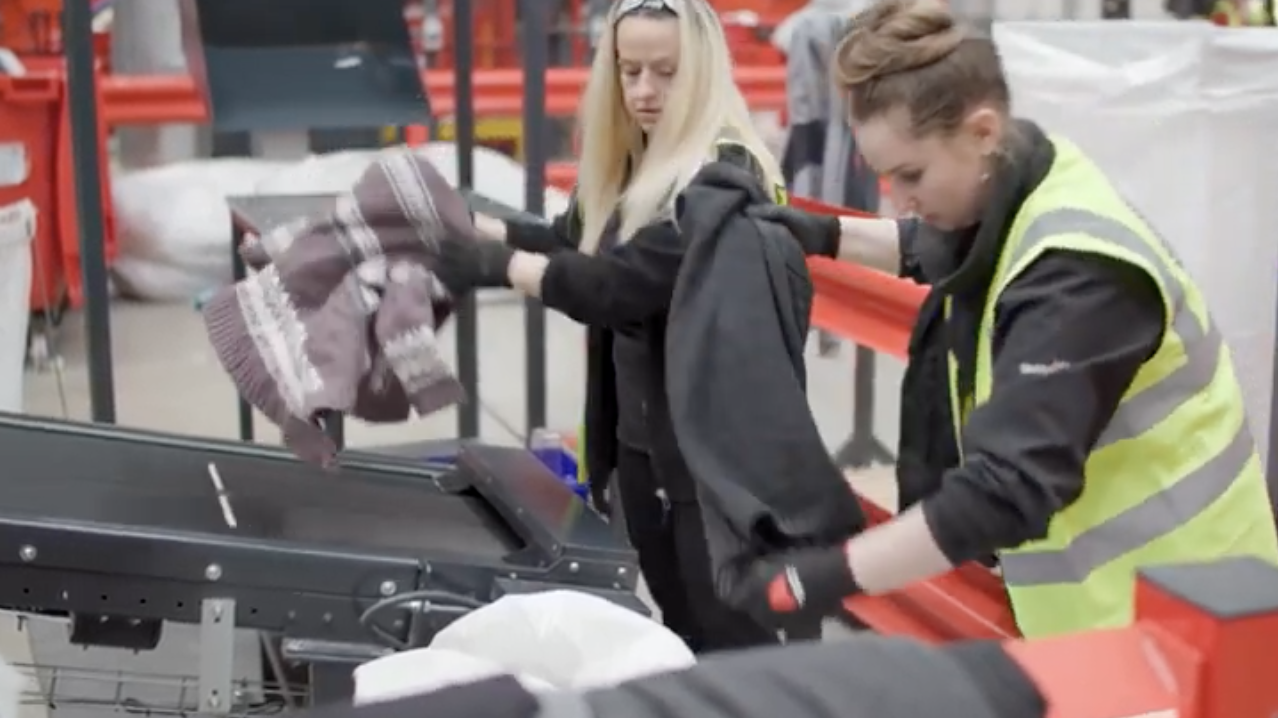
The New Fibresort Machine

Harriet Adjabeng
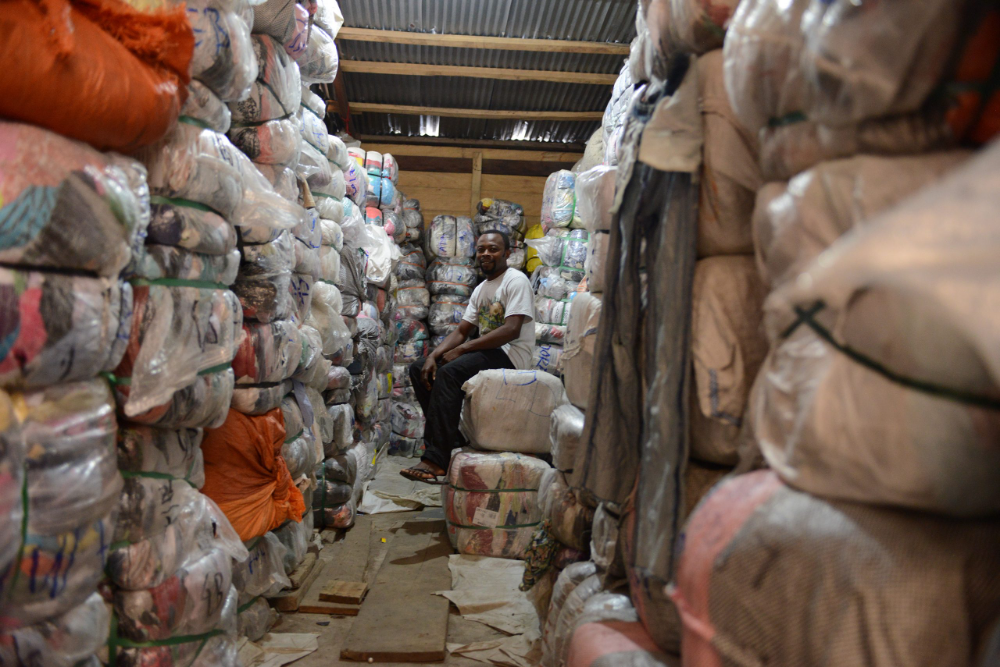
Inside Kantamanto Market
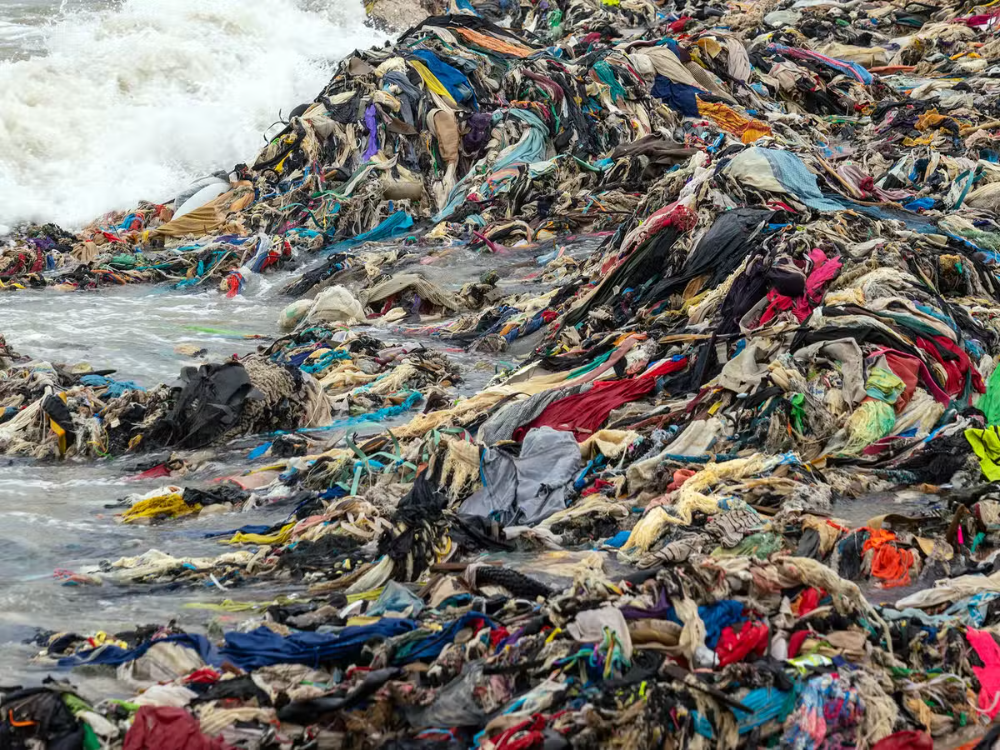
The Beach in Ghana
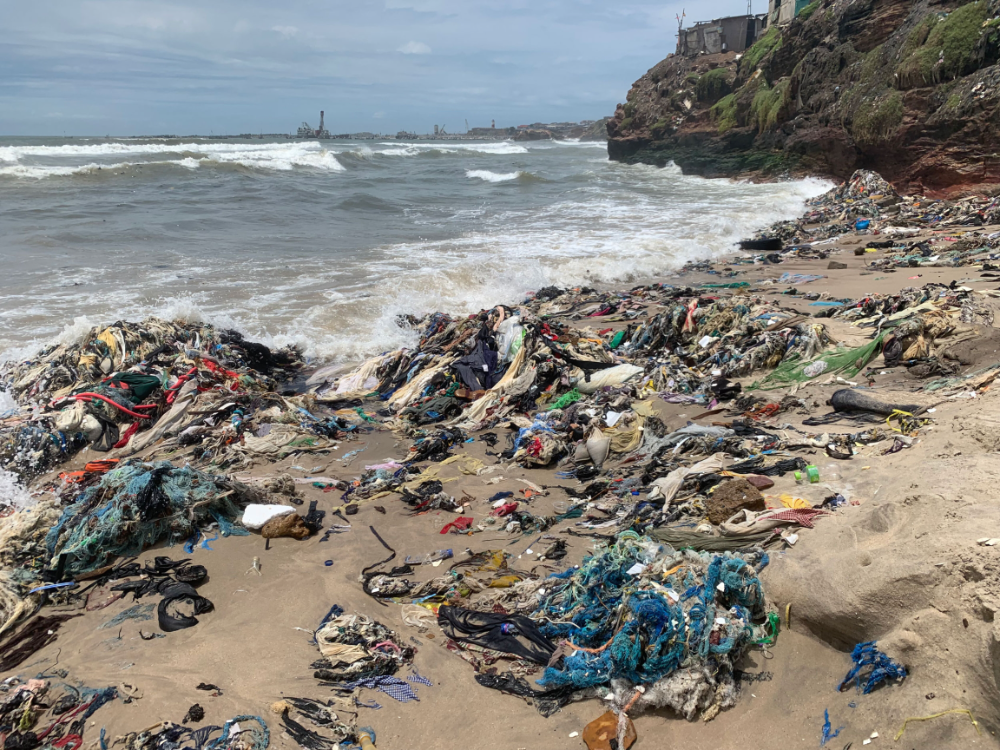
The Beach in Ghana
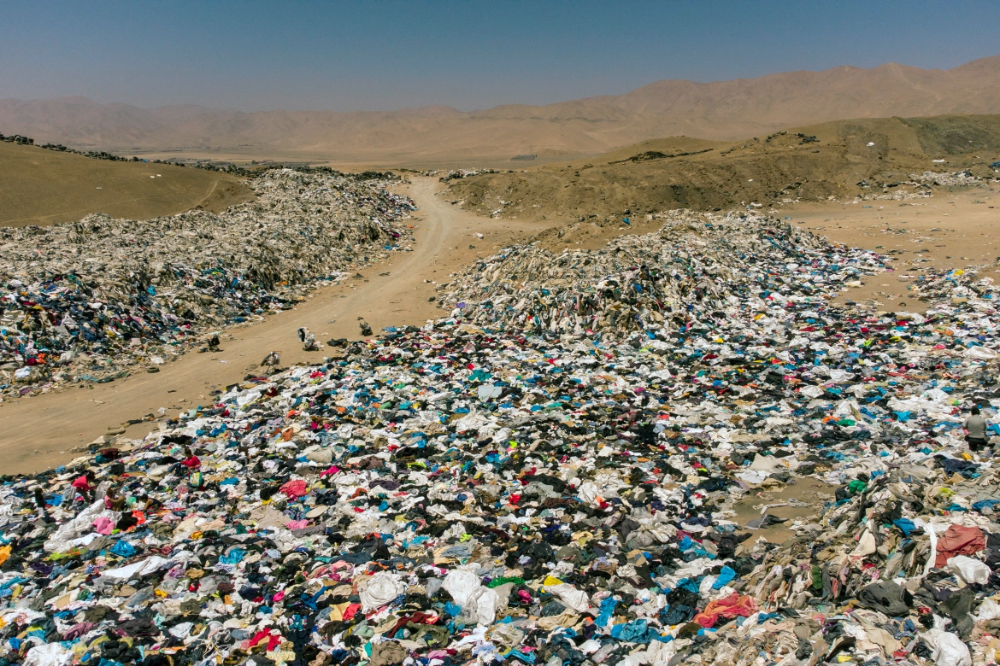
Illicit Dump in the Atacama Desert, Chile
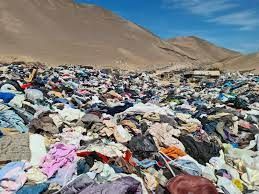
Dump, Atacama Desert

John Parkinson

John’s Determined Quest to Re-start
Shoddy Production

Linda Parkinson and the First UK Shoddy Run for Over 20 Years
Script for The Secret Life of Second-Hand Clothes
It’s a wet Sunday morning in Paris and we are on a trip to one of the great joys available to those who love textiles and haberdashery, a visit to the St Ouen Flea Markets, We are on the edge of the big Marche Vernaison in the company of Rebecca Devaney – who runs Textile Tours of Paris:
Rebecca: So we’ve arrived now in Marché Vernaison, which is the oldest flea market in Paris. Um, it started in the 19th century, quite organically. Um, when men called moon fishermen, uh, used to bring the spoils, uh, of their fishing trips in Paris, out here to sell them on the black market. And they used to use fishing rods to steal clothing and other items, uh, off washing lines under, um, the light of Moonlight or the lovely light of Moonlight. Um, so they’d bring them out here. And there was quite a collection of undesirables to be found around here. Um, and the city of Saint Ouen decided that they didn’t want to have this bad reputation. So, they accepted the reality of what was going on. And here in Marché Vernaison they started to build little kiosks that people could rent or buy eventually. S,o it developed into quite a community, which we have here today.
Welcome to Haptic and Hue – and Season 4 of Tales of Textiles, called Threads of Survival. My name is Jo Andrews and I’m a handweaver interested in what cloth tells us about ourselves as human beings. Textiles have an incredible power to talk to us if we can hear them. They comfort and console us, create memories, and define who we are.
This episode is about second-hand clothes and our changing relationship with them – once our clothes were deeply valued, made to last, with the expectation that they would be handed on and on.
Today our unwanted clothes pollute the world, damage the environment, and often end up in landfill. They are indeed threads of survival – but this is not a happy thing, they survive far too long and there is a horror to our current system of excess production and disposal – but there are also glimmers of hope as policymakers, companies, and charities slowly start to establish better systems of recycling fibres and clothes.
This podcast is about the past, the present, and what could be the future of second-hand clothes. It’s also about what really happens to the clothes you take to your local Goodwill or Charity shop.
Back in the Flea Market, everything comes from a time when quality mattered, and although it’s no longer stolen off people’s washing lines, these are the cast-offs of French life and Paris’s couture industry.
Rebecca: Okay. So here we are at Daniel and Lilie, um, and Daniel, uh, is in charge of their stand, which she took over from her father-in-law who opened it up just after World War 2. So Danielle and Lily specialize in beads, uh, and accessories for fashion, uh, beads and sequins. Um, here, we’re looking at the shop front and it’s filled with these gorgeous wooden boxes, um, filled to the top with treasures. Bonjour – Comment Allez vous?
Everything here dates from between 1850 and 1940 and if they didn’t sell it, it would be thrown away.
Rebecca: It’s a little bit like a haberdashery. They do galons, they do trimmings, they do ribbons and they do beads. Um, so the beads come from all over the world, and they’re made of all sorts of different materials. They have beads made of resin beads, made of glass beads, made of shells. Everything you can think of for beads.
A lot of the trimmings come from old makers of military and church passementerie. Just up the lane from Lilly is Laure, who sells second-hand French work clothes and French linen, some of which date back 150 years and is still eminently usable. A lot of these items were hand-made: hand-spun sheets of chanvre or hemp, embroidered linen, and work wear that was made of thick cotton and designed to last at least one lifetime. Laure sources all of it in rural areas and she says that in her experience it is not the French themselves who value it:
Laure clip 1: my opinion is strangers and tourists are more interested by all these than French people. They’re not very interested, really importantly, I think it’s sad, but it’s not the French, a real French culture for, for, for them. It was just useful to, to be used, but not, they didn’t know how nice it is, how nice it is and the quality of all fabrics.
These are vintage clothes – expertly curated by Laure who has a good eye for what she thinks will appeal to the modern buyer.
Laure: So my customers are, uh, strangers and tourist, and I work with cinema a lot with cinema, all quite all old film in, in costume. Uh, they often come here to, to take, um, clothes or textile or small thing to make for, for decoration. And I, I work as well with stylists who take all textiles to copy, to make for their, um <laugh> new collections.
And although there is something joyful about wearing vintage workwear and not buying new – the modern world of mass production intrudes even here. As Laure says, fashion stylists use these clothes as inspiration to create new designs that end up in our stores and online as garments to be sold to new generations of consumers, who may not realise that they reference back to vintage French work-wear and just want the latest look.
The Flea Market has changed a lot since it began life as a liminal place on the edge of town where second-hand clothes could be bought and sold – no questions asked – and where people on the margins of society found a somewhere to be, people like the legendary Roma French guitarist Django Rheinhardt who honed his skills in the clubs around here. He and other players developed a style called Jazz Manouche. It survives, and often for the price of a drink you can still catch it in the local bars and cafes.
The people who developed this glorious music and those who started the Flea Market – lived at a time when every scrap of fabric was hard won and treasured. Clothes took so much time to make from raw materials that they were handed down. In France, the people who had this job were called Chiffoniers, second-hand dealers, or more prosaically rag dealers.
Lisa Wollett – who comes from a long line of British dustmen or refuse collectors, recently wrote a book called Rag and Bone – A History of What We Have Thrown Away: in it, she describes what happened to second-hand textiles in London during the mid 19th century:
“Rag gatherers supplied a more complex market through the city’s vast number of rag merchants and old clothesmen. Everything would be carefully picked over. Once any saleable second-hand clothes had been separated, much of the rest could be sold on to rug makers and paper mills, or to upholsterers for use as stuffing. Scraps and seams would be left to rot and then sold as manure, with any left-over wool shredded and sent to the shoddy mills. Any left that was too short to spin would then be baled up and sold to farmers in Kent, where it was dug into hop fields to improve the soil…..nothing was wasted and almost every last scrap had value’.
She goes on to say that “with its great dust yards and armies of unofficial scavengers, the early Victorian city was close to producing zero waste”.
Today, we live in anything but an age of zero waste – instead, this is the era of textile excess, where clothes are cheap to buy and quickly discarded. Second-hand clothing is everywhere and there’s too much of it. Kirk Bradley works for the Salvation Army’s Trading Company in the UK – his job involves finding destinations for some of the huge volume of clothes Britons discard every year.
Kirk: We operate 230 charity shops and donation centres across the UK and they will take donations from the general public over the threshold. But in addition to this and probably most of the volume that we collect is, is operated from our 8,000 plus textile banks that we have mainly on supermarket car parks and also, we deal with a lot of the local authorities. So we’ll have textile banks on local authority land. In addition to this, we work with some of our corporate partners and we get donations. So that’s customer returns, end-of-line products. In addition to that, we operate various in-store, take-back schemes with various retailers. And we also have a takeback scheme where customers and members of the public are able to donate textiles to us. Currently, we process and reuse around about 63,000 tonnes of textiles.
The Salvation Army is just one operator in this field and it works hard to make sure that it is ethical and responsible. Every day around 8 large truck loads of textiles arrive at the Salvation Army’s sorting centre in the East Midlands where it is sorted and bagged.
Kirk: Initially our charity shops have options to take any product. If they’re low, generally they get enough product over their threshold from donations locally. The Salvation Army always have the ability to contact us directly for stock and there can be certain campaigns or certain times when they do so, things like the Grenfell fire. We supplied volumes of textiles for those people that were caught up in the fire and things like the Afghan patriation period where people who worked with the army were brought here to the UK with very little, we would supply those with textiles.
UK usage accounts for just 14% of the textiles that come into the Salvation Army’s sorting centre. Kirk has to find a home for the other 86%:
Kirk: So, therefore, there’s a huge volume of product which is outstanding and needs to be dealt with. And there’s a demand within less affluent countries around the world that are crying out, for Western clothes and second-hand, cheaper clothing. So really without this export market, there’d be significant values and textiles going into landfill. And just to give you kind of some sort of clarity on where those kinds of destinations are. Around about 40% of it will go either in Eastern Europe or the rest of Europe, and then the other 40% will go around to the Middle East and there’s, and then there’s various anomalies of small, small donations going or small products or going to other countries around the world.
These clothes are sold wholesale to customers in Poland and Ukraine and then if they go to the Middle East they are sorted into different grades and distributed onwards to different parts of the world. The Salvation Army checks carefully to make sure that these textiles are responsibly used:
Kirk: We need to make sure that, you know, they fall within our, our remit, our ethos and, within the law in those countries as well is very important. And as part of the business, we have, you know, we class ourselves as custodians of the planet. And therefore, we need to make sure that, you know, as far as possible, everything can be, if not, if not reused, but will be recycled. And some of the other things to understand is these, these customers of ours are actually paying for these products. So they need, they will make the best of that product as they can. And therefore, if there’s products that aren’t re-wearable, there’s various markets for that, including flocking, you know, the product can go into a soundproofing, carpet underlay, those sorts of markets that are, are, are already there. And, you know, we ensure that our customers act responsibly with the product that we give them. And therefore, you know, we’re comfortable, you know, with the checks that we do that, as I say, 98% of the product that we give them is either used to be reborn or is recycled.
But this is not always the case as Kirk knows – second-hand clothing and unsold clothing from the rich northern countries end up polluting poorer southern countries. Some of the most shocking images come from the Atacama Desert in Chile – A beautiful and remarkable environment that is the driest place on earth. Horrifically parts of it have been turned into a fast fashion graveyard with piles of unwanted and unusable old clothes from North America and beyond -threatening a fragile eco-system and the health of local people.
Kirk: Yeah. I think there is, certainly operators out there that will do that. I mean, the second-hand clothes market is, is huge around the world. You know, the UK market is fairly well governed, I would say with you know, membership of the likes of the Textile Recycle Association and the Charity Re-cycle Association. Unfortunately, there will continue to be those that exploit the systems. But we can only do what we can do. And what we are doing is, is, is the right thing to ensure that the customers that we use around the world are doing things in, in, in the correct manner and ethically and fall within what we are at The Salvation Army team think they should be doing.
Accra in Ghana is home to West Africa’s largest second-hand clothes market, the famous Kantamanto market: Harriet Adjabeng knows it well:
Harriet: Mondays and Wednesdays are normally the market days where bales get into the market, they get opened and it’s, it’s so much, it’s really so much that goes on there. It’s very exciting to see how the retailers get their bales, open their bales. Young girls who are head porters, or we call them Kayayeis in Ghana, carry the bales from one end to the other. And it’s quite interesting. Like the activities within the market is really interesting to see. Yes.
Harriet is a fashion writer and researcher who is currently on a fellowship in the US. She intends to set up an online sustainable fashion community information center as her follow-on project in Ghana to help educate the textile industry about sustainable solutions – which is a million miles away from what we have at present. What she is describing is how the clothing bales arrive in the market twice a week. There is excitement, but this is a tough game for the market people who live on the margins:
Harriet: so what happens is that they take loans. They go to the banks, there’s small savings and loans organizations or financial institutions. They take loans to buy the bales. And it’s more like a game of gamble. <Laugh> you are not sure you are buying something that you have absolutely no idea about. But I spoke to one of the retailers, he mentioned that the bales actually are segmented. So you have the ones that is between fifty to a hundred dollars. Then you have the hundred dollars to two hundred dollar bales, and you have from 200 to two hundred and fifty or within, just within that range. So the higher, the higher it goes, the better, the quality you understand. So depending on how much money you have in your hands is what you are getting.
In Ghana, the bales come from the UK, the US, Canada, and other European charities and textile dealers, and the truth of the matter is that many of the suppliers just want shot of this stuff and they don’t really think about what’s suitable for the Ghanaian market, which impacts on the traders.
Harriet: They always complain about the fact that certain times, when they buy the bales, you are optimistic about the fact that you are going to open these bales, find really interesting things that you are going to sell. But unfortunately, you open the bales and realize that almost 90% of the pieces in the bales cannot be sold. It’s just very few of them. You’ve gone for loans. How are you going to pay for these loans? If, if you don’t sell it. And it’s one of the things that breaks my heart a lot, because most people’s lives are dependent on this business module. And, if you are taking loans to actually buy these bales and you’re not getting any returns, I feel it’s a bit unfair if you ask me. Yeah.
And the unfairness – which in my view is a mild word for what Harriet describes – doesn’t end there. Here’s what happens to the clothes that can’t be sold in Kantamanto Market.
Harriet: It’s choking us. It’s crazy. So, when the market women are done sorting out what they want to sort out, they sell, whatever they want to sell, they leave the rest in the markets where the waste pickers come and pick them up. And even the process of transporting them to unauthorized landfill is also a problem because certain, some of them get dropped off on the road. They, get dumped at around slums where they get dumped at unauthorized dumping sites. So, you go to our beaches, you find lots of them in our beaches, they get, they get swept to the, to the, to the what’s it called to the shores of the beaches. And it’s just everywhere, just everywhere in your face, everywhere, they clog our gutters. And when it floods it’s crazy, you literally find, all these fast fashion giants. You have pieces from them, just scattered all over the place and staring you right in the face, because there’s really nowhere to take them.
Harriet had never seen a clean public beach until she left the Accra region. She also knows that the environmental cost of all this clothing is high with mountains of textiles in unauthorised dumps, on the edge of the slum districts smoldering, as people try to set fire to them – let alone the impact on wildlife and sea life.
This is the depressing present where our old clothes – which we might think we are giving away responsibly, in effect end up dumped on poorer countries often with unregulated systems where they pollute, harm, and truly become Threads of Survival long beyond their useful lives. But the future doesn’t have to be like this – if we don’t want it to be. Harriet sees that a better future is possible for the Kantamato market. Interestingly she doesn’t want it closed or the trade in used clothing banned as it has been in Rwanda:
Harriet: There is actually a silver lining in it. If the activities are regulated properly because it’s a business that most people are dependent on. That is where they get their meals from. And it’s Hmm. I don’t think generally, I don’t think it’s actually a bad business. If we look at it properly the institutions invest in research into the module to properly regulate it. I think it, it will be a source of employment and it will I want to use the word. It will increase economic independence. Mm-Hmm <affirmative>
There is tremendous energy and the joy of hunting for a bargain in these places. Across Africa, there are lots of names for these clothes and the way they are sold, like Bend Down Boutiques, or sometimes they are called Dead White People’s Clothes, or in Mozambique – the Clothing of Calamity. Harriet believes the best way forward is for Ghana to work with the fact that it receives the fashion waste of the west.
Harriet: Let’s assume, or we’ve accepted that Ghana has become a dumping ground, more like it. So now it’s more like a land field than an actual business module. So it’s more like, okay, we are going to just make the pieces whether or not they are good or in fashion, we always have a way a place to dump them. But the opportunity in this is that if these brands actually focus more on establishing a proper fashion waste recycling plant in Ghana, it would do us a lot of good. So yeah, bring us, the waste. You are free to bring us the waste because you’ve established a proper recycling fashion waste, recycling plants, where all these pieces will be, will be recycled into some other things, and it will offer job opportunities to people within the second-hand supply chain.
Back in the countries that generate all these textiles, there is also much more that can be done to stop clothes from being dumped on countries like Ghana or Chile. Here’s Kirk Bradley of the Salvation Army’s Trading Arm.
Kirk: We saw some five, six years ago that this market needed to change, you know, having conversations with some of our retail customers, those who are in the fast fashion industry, And therefore, as a business, we started to look at how we could support our partners and how we could help in the environment. You know, at the end of the day, basically as a country and, and across the world, I think in certain areas, you know, we, we over consume, therefore, you know, there needs to be a change. There needs to be a change in our buying habits. And we need to consume less and look for alternative methods, you know. However, there’s always going to be a requirement for clothing. And therefore, there’s always a need to be, some way that we can preserve the natural resources that we have in the world and recycle as much as we can of the manmade products.
One of the changes that is helping this is the introduction of a revolutionary sorting machine by the Salvation Army. It automatically sorts textiles at speed by quality and by fibre:
Kirk: How the machine actually works is we’re able to sort clothing. We will grade them into A, B, and C. A is what we class as a shop grade. So that goes into our charity shop. B grade will go into our export market and C grade is deemed to be unwearable and that product is placed through into our fibre sort machine. And it goes through a near-infrared camera, which can identify the fibre composition, and then a camera that checks the colour and analyses the colour. So this machine’s able to sort up to 4,000 different recipes, so that’s colour and fibre type. And, so, therefore, if, you know, we wanted to remove or wanted to take out, you know, 50 percent cotton, 50 percent polyester products, then we could actually put them through the machine. The machine will identify those products and will sort accordingly.
And that makes it much simpler to supply recyclers with the product they can use:
Kirk: And it does it very quickly because it’s an automated system. So at the moment, it’s easy to find recyclers for example, with a hundred percent cotton and a hundred percent wool garments. So yes we can, we can put that through the machine and then we can isolate that product and send that product to different customers. The more complex issues are the multi-fabric products. So as soon as you start getting you know, polycotton, viscose, nylon, all those sorts of blends into, into a garment, it becomes more challenging, to recycle. So there’s definitely a challenge still here for us to do the technology, but there’s, there’s an awful lot of work going on behind the scenes with chemical processes to try to be able to remove polyester from cotton.
One of the people The Salvation Army’s Fibresort machine is now supplying is someone who has appeared on this podcast before. If you listened to The Once and Future King, in Series Three it told the story of shoddy, with the help of John Parkinson who grew up in the shoddy trade. This is a two-hundred-year-old process developed in the heavy woollen district in West Yorkshire. A machine called a Devil ripped old woollen garments and rags to pieces, which were then carded, blended with new wool, and re-spun into yarn that was woven into new garments. The last shoddy mill closed in Britain over 20 years ago. But John – ever persistent – has been searching for a way to restart shoddy production in West Yorkshire.
John: The world’s crying out for it, and we’re determined to not just protect the, industry and the craft, but to re-energize it. And we want to learn new techniques, as well as bringing the best of the old, we want new generations, people that can bring new technologies and new ideas to train new generations, to keep this trade going and to do it better than we can.
We left John last year with a bit of a cliff-hanger on his hands, a race against time to find a partner who could house his shoddy machinery, provide some wool waste from their own production to feed into the shoddy process, and maybe make use of some recycled wool themselves. Well, he succeeded – at the last minute in finding his partner in Camira – the makers of wool moquette, bus, and metro seats around the world. The day I spoke to him he and his wife Linda had just succeeded in making the first new batch of shoddy in Britain on the new machines:
John: Coincidence, whatever coincidences are, but today was the first day of actually putting some hard waste through the machinery. So like it’s been quite a day really. And we always have like a few little things, adjustments and tweaks and teething and all that kind, but it’s, we just did one small batch 120 kilos of some roll ends and piece ends that were Camira’s, it was wool cloth. And it went, went through really well and, and made a really nice product. And the machines performed as I expected them to I’ll or beyond the expectations, really. So today’s been the first day that we’ve crossed. So the first day that shoddy trade has come back to the UK after being out for 22 years with the last one, when it was, they were just hanging on by the fingertips. So quite a momentous day, really in many ways.
That’s a huge step forward for John and Linda – but this isn’t a simple task. In the old days, the shoddy trade depended on an entire integrated market of rag and bone men, rag sorters, shoddy manufacturers, and critically, garment producers who understood how to use recycled yarn – all of that has gone and has to be re-constructed:
John: So we’re building the supply chain, we’re building the market, we brought the machine back, but there’s, it’s not like it were in the old days. It’s a new kind of way. And, and to be fair, you know, we, we are finding our way in this new, new world where rag merchants aren’t there. There is a market developing that, but, but there’s still there’s still lots of knowledge gaps in terms of what can be done and what can’t be doing and what might be expected.
And this will take time – but at least a start has been made and John is open to trying all kinds of ways to establish new uses for recycled wool. One thing is certain, his joy at seeing shoddy created never leaves him:
John: Absolutely the same kind of joy. I mean, I watch the processes happening right from the sorting, and then what we call pulling, the shredding, the opening up then as it goes from blending into carding and spinning, and then making into new stuff, and I’m watching it, and it’s, it’s just a magic show. Like, even though it’s all I’ve known and I still, you know, standing gazing wondering, can we do that? Can we turn this stuff into this? How is this happening in front of me, eyes? And that, you know, just the excitement that when you get a new project to work on it, a new yarn to make a new colour and you, that just, just the potential, just that, you know, being involved with this amazing transformation is, is just a joy and a privilege to be part of.
Kirk Bradley says the technology has come a long way in five years and he believes it will travel even further in the next five years. And appropriately for a Salvation Army man he has his own Holy Grail firmly fixed in his mind:
Kirk: Textile to textile or fibre to fibre is kind of the holy grail. You know, we saw that as a significant opportunity and our vision is to be the first organization in the UK to scale this up. So, we’re looking at what we class as a fibre farm. That fibre farm will be able to take these mixed blends a hundred percent polyester and, and meet the requirements of the growing recycling market. And the Fibresort machine is kind of the first step of making that reality. However, there’s still a lot of work and discovery to be done. So the dream is for us is to have this fibre farm and be able to give raw material back into the fibre to fibre industry and the fashion industry.
And that would be part of Harriet Adjabeng’s dream for Ghana too – once she’s got the fashion industry and Western Governments to clean up the dumps in West Africa – but for now she has some sound advice for today’s consumers:
Harriet: And I also believe that we, the customers also have strong part to ask uncomfortable questions. <Laugh> brands ask our brand their uncomfortable questions, where when you are donating clothes, where are these clothes going when you are even investing in pieces at these pieces? I feel that cause when you are buying something, when you are donating something, ask yourself, if this thing gets sold to me the next time would I want to wear it? So invest in good clothes so that when you are, when you are donating them or giving them out, you know, that this thing is going, is going to somebody who will value it or someone who will sell it and get some really good returns on it. So I believe with the customers also have the power to ask brands, questions, and share as much as possible to invest in quality that when we are donating them, we know we are supporting a good cause.
Thank you for listening to this episode of Haptic and Hue, and a huge thank you to Rebecca Devaney, Kirk Bradley, Harriet Adjabeng, and John Parkinson – may all their dreams come true.
If you would like to see pictures of the processes and machines, as well as the horror of the clothing dumps in West Africa and Chile, or read a full script, head over to Haptic and Hue’s website at www.hapticandhue.com/listen.
Haptic and Hue is hosted by me Jo Andrews and produced and edited by Bill Taylor. It is an independent production supported entirely by its listeners, who bring us ideas and generously fund this podcast via Buy Me A Coffee. If you’d like to contribute you will find the button on our website at www.hapticandhue.com.
Haptic and Hue will be back on the first Thursday next month with a wonderful tale from a community of self-sufficient textile artists who thrived in a tough sea-faring town on America’s East Coast.